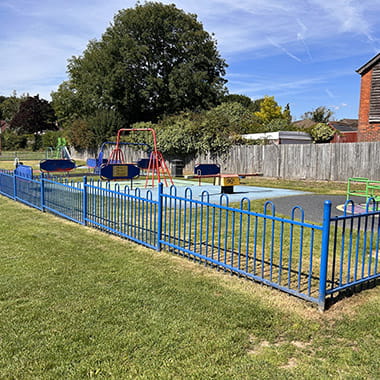Our other sites:
Project Overview
Client
Abbey New Homes
Location
Sandwich, Kent
Date Complete
2023
Sector
Residential
Background
Play is an essential part of children’s development. The benefits of outdoor play in particular include exposing them to fresh air, nature, and increasing vitamin D levels, and helping them develop limits, boundaries, self-confidence, independence, and self-esteem.
In November 2006, the Department for Communities and Local Government (CLG) launched Planning Policy Statement 3 (PPS3): Housing. This document was one of a series aimed at local and regional planning bodies to help them put in place an effective policy framework for family housing that includes play spaces, parks, recreational facilities and gardens for children and young people. Since then, the requirements for outdoor play areas are written into planning proposals for housing developments under councils within the UK, to ensure they give regard to PPS3. Each council states that a residential development consisting of 25 or more houses must include a children’s play area.
An overview of the play areas specified depending on the requirement:
Local Area for Play (LAP)
Should be within a one minute walking distance on a well used pedestrian route. Includes equipment for children aged 6 or younger. Minimum activity zone of 100m2.
Local Equipped Area for Play (LEAP)
Should be within five minutes of walking distance on a well used pedestrian route. For children who are beginning to play independently. Should have a minimum of 6 play experiences and 3 individual play items. Minimum 400m2 activity zone.
Neighbourhood Equipped Area for Play (NEAP)
Should be within 15 minutes of walking distance on a well used pedestrian route. Targeted at older children but should have an area for younger users, with 5 individual items. A minimum space of 1000m2 divided into two sections.
If any of the play areas are near roads, it must have fencing around to keep children safe and exclude dogs.
Unfortunately, some housebuilders are failing to comply with these regulations. Often, only a fence is installed to designate where a play area will go, with the play area never being built, leaving empty space. Materials shortages or costs are regularly cited as reasons for promises not being followed through. One estate is reported to be charging a maintenance fee of £100 a year per resident, for the non-existent playground. Residents of a different development were sold the dream of a lush, tidy, and secure green play area, but are instead dealing with a play area that turns into a bog when there’s heavy rain, with no fencing or gate.
We are pleased to see how one housebuilder is following requirements and also thinking about their reputation as a housebuilder by not only doing the minimum but thinking about the future of the development. Montagu Place in Sandwich, Kent, developed by Abbey New Homes, offers contemporary living in a vibrant medieval town. The estate features 120 3 & 4 bedroom family homes and includes a LEAP play area.












Solution
To create a safe boundary around the play area, our timber Playtime® playground fencing was installed alongside a double leaf and single leaf gate.
It is recommended that the whole perimeter of the play area is fenced, as this provides an area that children can safely play and reduces the chance of children running off or dogs entering the park.
With timber equipment inside the play area, the timber fence continues the natural aesthetic. Made from smooth planed wood to minimise splinters, with pale spacing that conforms to RoSPA, BS EN 1176, and building regulations, Playtime® provides a child-safe fence which reduces the risk of injury. Pales are sandwiched through rails to create a robust fence that withstands attempts at vandalism, which unfortunately is common with play areas.
To provide safe access points into the playground, gates feature green polyester powder coated frames to clearly indicate where they are within the perimeter, and self-close, soft-close mechanisms. In addition to a single entrance gate, a double leaf gate is recommended to provide access for maintenance or emergency access if required.
The fencing and gates were provided with a 25 year guarantee against rot and insect attack, offering an attractive prospect for the housing developers to improve their long term reputation and putting homebuyers at ease while reducing the chance of children harming themselves when using the play area.
Read about the regulations for fencing around new build housing estates in our blog.
Products Used
Ready to find out more?
To discuss your requirements please call us or fill out the form below and someone from our sales team will be in contact with your quote shortly.
Request A QuoteRelated Products
Find related products for your order. If you cannot find the item you are looking for, please do not hesitate to call our friendly sales team.
Top




